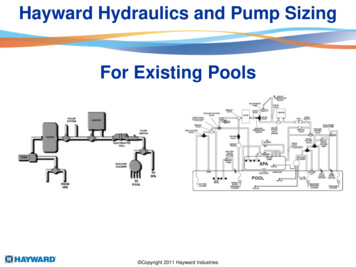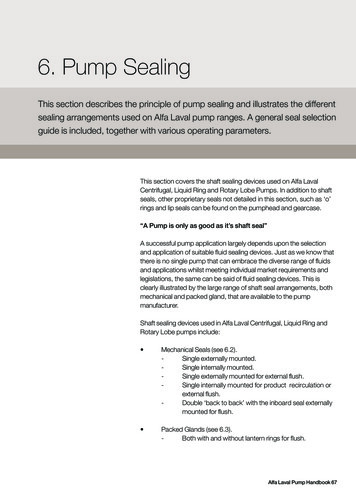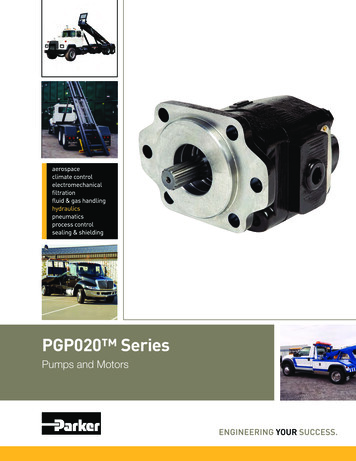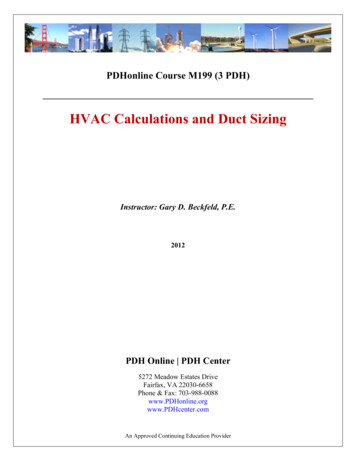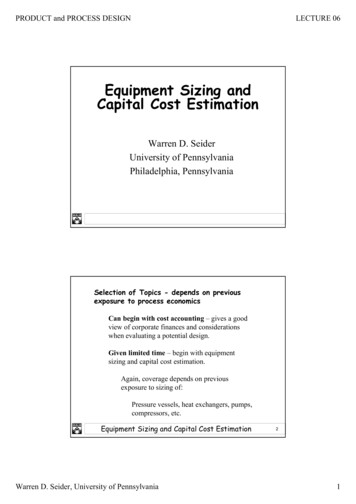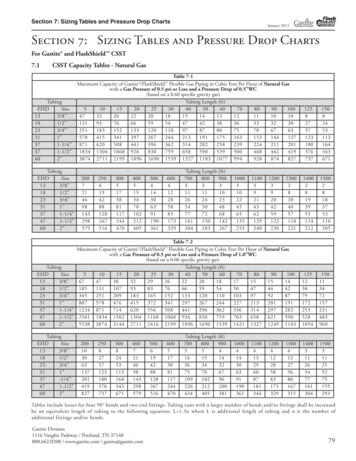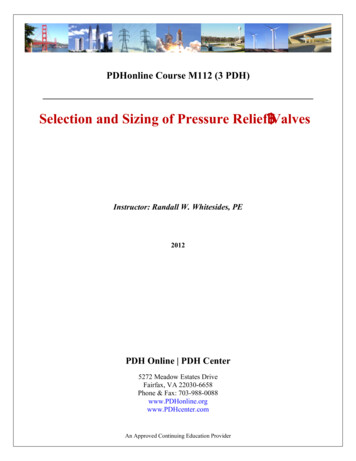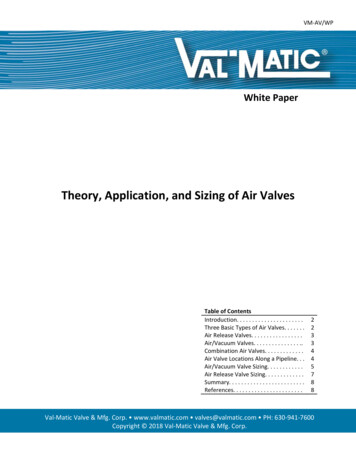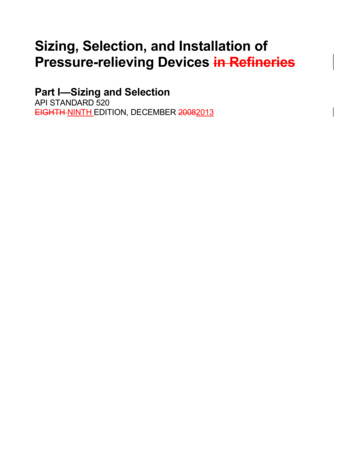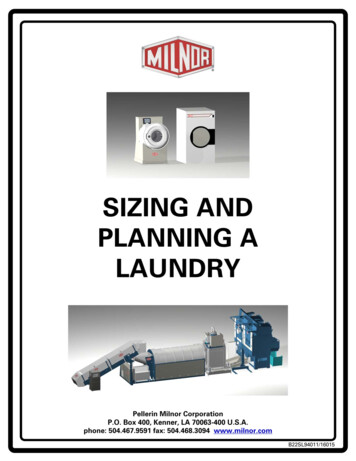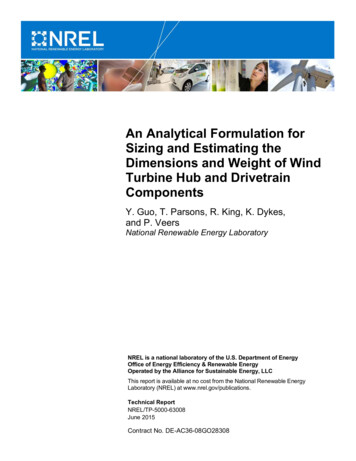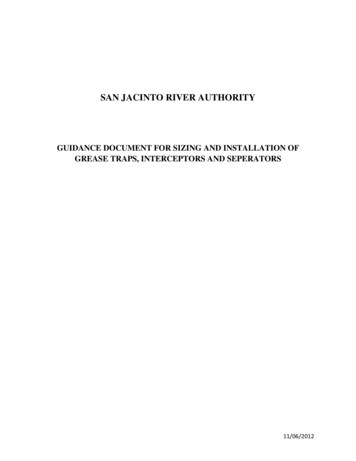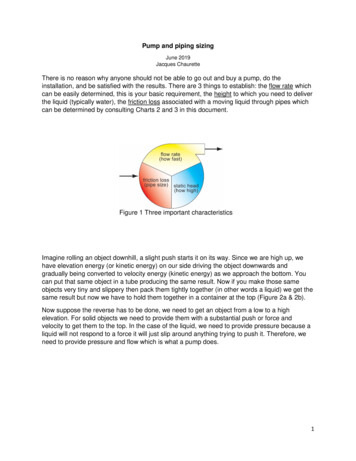
Transcription
Pump and piping sizingJune 2019Jacques ChauretteThere is no reason why anyone should not be able to go out and buy a pump, do theinstallation, and be satisfied with the results. There are 3 things to establish: the flow rate whichcan be easily determined, this is your basic requirement, the height to which you need to deliverthe liquid (typically water), the friction loss associated with a moving liquid through pipes whichcan be determined by consulting Charts 2 and 3 in this document.Figure 1 Three important characteristicsImagine rolling an object downhill, a slight push starts it on its way. Since we are high up, wehave elevation energy (or kinetic energy) on our side driving the object downwards andgradually being converted to velocity energy (kinetic energy) as we approach the bottom. Youcan put that same object in a tube producing the same result. Now if you make those sameobjects very tiny and slippery then pack them tightly together (in other words a liquid) we get thesame result but now we have to hold them together in a container at the top (Figure 2a & 2b).Now suppose the reverse has to be done, we need to get an object from a low to a highelevation. For solid objects we need to provide them with a substantial push or force andvelocity to get them to the top. In the case of the liquid, we need to provide pressure because aliquid will not respond to a force it will just slip around anything trying to push it. Therefore, weneed to provide pressure and flow which is what a pump does.1
Figure 2a Solids and liquids moving down.Figure 2b Solids and liquids moving up.2
A pump produces pressure, but the term head is used instead, fortunately there is very simpleand direct relationship between head and pressure. Head is directly proportional to pressureand you can see some typical values for water in Table 1. In Figure 3, we see how pressure andhead are related. Pressure will be produced due to the weight of water at the bottom of a tankand the same is true of a piping system. The head or in this case static head is the height ofwater above the location of interest.Figure 3 Pressure in a tube vs. pressure at the bottom of a tank.Table 1 Pressure to head values for water.3
A typical pump system user is faced with a bewildering set of conditions and terminology when itcomes to selecting a pump and associated parts. I will answer some basic questions withoutusing any complex formulas or calculations using a few charts and basic concepts that we areall familiar with. In particular:-What is a pump system?What is the role of height (i.e. head) in a pump system?How is velocity defined for a liquid and how does it help us determine the optimaldiameter of a pipe or tube?What is the role of friction and why is it called friction head?What are the important characteristics of a pump?How do you select a pump for a given application?Why are we using head instead of pressure?A pump system consists of a pump, usually some sort of tank for storing or supplying liquid, andpipes or tubes to transfer the liquid from one place to another. The start of the system is at thefree surface of the suction tank and the end is at the outlet of a pipe or the free surface of adischarge or storage tank. Here are two typical systems.Figure 4 Two typical pump systems.4
How high do you need to deliver the liquid?From the perspective of finding the correct pump size or capacity, it is the difference inheight between the high point and the low point that needs to be considered. This is nodifferent from lifting a set of weights in the gym, you start from the floor which you can set atzero height and you lift it as high as your arms can go vertically, that height minus the floorheight is the height you will have to lift the weight, for example 6’ – 0’ 6’; we can alwaysset the lower height to zero and measure from there.Since there are a multitude of systems for different applications here are a few of them withtheir high and low points.Figure 5 Locations of the system low point and high point.As you may have noticed the low point and high point correspond respectively to the start andend of the system.What are some of the errors we can make when choosing the high point or low point?5
Figure 6 Errors in locating the system low point and high point.How fast do you want to transfer the liquid, or how many gallons do you want to transfer perminute?Do you want to fill a 5 gallon bucket in 1 minute or 10 minutes. The flow rate in the first caseis 5/1 5 gals./minute and in the second case 5/10 0.5 gals./minute or gpm.How does it get there?The pump is the engine and the pipes or tubes are the pathway or road. If you have to getup a steep hill in your car, you won’t be able to go as fast as on a flat road, because it willrequire more energy, perhaps more than you have available. The same applies to a pump, ifyou want to transfer a liquid quickly to a high point it will be harder to get it there.What if you need to transfer a liquid horizontally or to a destination at the same level as thestarting point? If the tube is long, it will take more energy to transfer a liquid at a high rate vs.a slower one. Like a car, it takes allot of energy to drive fast on a flat road, consider aPorsche vs. a Subaru. The faster you go the more energy is required.The pump and the tube size or diameter are the 2 elements that typically can be changed.The bigger the pipe the easier it is to increase the flow rate within reason. It will not help youto go from a ½ in dia. tube to a 3 in pipe. Or maybe it would if you have completely misestimated the size of tube required. To avoid this problem, we need to look at velocity andfriction which we will deal with further down. To increase the flow rate, you could also put in6
a bigger pump, often it is easier to change the pipe or tube than to change the pump. Inpractice, to get the optimal system you have to select the pump capacity (i.e. flow rate) andhead in conjunction with the right pipe or tube size to get the flow rate you intend at thedestination.How do you know if changing the pipe will make a significant difference? Calculating theamount of friction that the water encounters in the pipe will determine whether it is worth it ornot.In many typical home projects, this is all you need to know about how to size your system.However, if you are looking to avoid extra cost on your materials, for example, selecting andpaying for 1” dia. tubing when you only need ½ in tubing, then we need to look at whyfriction matters.What haven’t we talked about?Static head and pressure.Velocity, friction, and viscosity.Static headStatic head is the height of water above a given reference point. The suction static head is theheight of water above the pump suction or intake. Discharge static head is the height of waterabove the pump discharge. Total static head is the difference between these two, this is thehead that the pump will have to produce to at least get the water up to the high point.Figure 7 Suction, discharge and total static head.The total static head is what we determined in the first part. It’s the difference between thelevels of the free surfaces of both tanks. The selected pump should have more head than justthe total static head since you need to account for friction. Remember that even a pipe that runshorizontally will produce friction in the liquid and more head is required to account for this.7
Whether the pipe is running horizontally or vertically, it’s the length that counts when wecalculate friction.Pressure is a little trickier to visualize; a balloon is a good example; when you blow it up youneed to produce pressure to get it to inflate. Pressure is produced by the pump; it is the drivingforce that moves the liquid. It is not possible to push a liquid because of its low viscosity that’swhy we need pressure.Imagine that you have an object that you cannot hold, pick-up, push or affect in any way. Howdo you get it from one place to another? This is a fluid. Fluids are always in containers becausethey cannot hold themselves. You can move them around by moving the container. But what ifyou need to move allot of it? What if you don’t want to go to the well several times a day to getthe water that you need. Then you need a device that can pressurize water within a container,or a pump.A force is required to move solid objects, pressure is required to move liquids.8
The terms low and high point for static head are perhaps not the best qualifiers becauseit is quite possible that the high point is actually lower than the low point. Better termsare inlet and outlet of the system.Velocity, viscosity and frictionVelocity is the key to friction. To calculate the velocity, we take the flow rate and divideby the cross-sectional area of the tube. The area is d2 / 4 and the flow rate is whateverwe require.The following table shows the tube diameter vs. the velocity for different flow rates.Velocity does not tell us much on its own. However, it is essential for calculating frictionalong with its viscosity.Table 2 Velocity, flow rate and tube diameters.9
Chart 1 shows the flow rate vs. the velocity for a 0.5” diameter pipe and the friction loss asmarks along the curve. For example, a flow of 5 gpm for an 0.5 in pipe diameter has a velocityof 8 ft/s and produces a friction loss of 77 feet per 100 feet of pipe. That friction loss is high andwould be a strong indication that a bigger tube is required; a diameter of 0.75” is more suitableand would produce a friction loss of 10 ft/100 ft of pipe. You can verify this with chart 2 and laterwe will discuss why friction has this curious unit of feet per 100 feet of pipe.As a guideline, any velocity above 12 ft/s is considered high and will create a high level offriction loss.Chart 1. Friction values for a 0.5” diameter tube.10
Chart 2 provides the friction value for several pipe sizes. If the friction is high then wemay want to consider a bigger pipe. Let’s do an example, say we have a flow rate of 6gpm and we are using a 0.75” diameter pipe or tube. Then the velocity will be 4.5 ft/sand the friction 18 ft per 100 ft of pipe. The reason friction is given in ft per 100 ft of pipeis that the pipe length will be different in each application. Let’s say your pipe is 20 ftlong, then the friction is 18 x 20/100 3.6 feet.It sounds a bit strange to have friction in units of feet. The reason is it can be added tothe total static head which will then provide you with the total head of the pump.Here’s a way to visualize this - see Figure 8. Take the end of the tube that is connectedto the discharge side of the pump and raise it up vertically, at some point the flow willstop and this will correspond to the maximum static head you can achieve with thatpump, however there is no flow. To get flow you have to lower the end of the tube. Howmuch do you have to lower it? To get to your required flow, for example to 6 gpm you willhave to lower by 3.6 feet.Figure 8 Friction head.11
Chart 2 Friction values for different flow rates, pipe diameters and velocities.12
The typical home project often involves small diameter tubing. Chart 3 provides friction lossvalues for small tubing. When the flow rate is small, the flow rate is often given in gallons perhour (gph).Chart 3 Friction values for different flow rates for small pipe diameters.13
The last question to be asked is how do you select the right pump? We know how to calculatefriction head and we can easily measure the static head. Let’s say the static head is 16.4 ft andthe friction head is 3.6 feet, then the total head of the pump will be 20 feet. How do we find apump that will gives us 20 feet of head at 6 gpm?All centrifugal pumps operate on what is called a performance curve or a pump curve. Thecurve shows that there is a relationship between the head produced by the pump and the flowrate.Figure 9 Typical pump performance curve.The two most important characteristics of a centrifugal pump are its flow rate and head. Themanufacturer will provide the head and flow rate at the best efficiency point of the pump or theB.E.P and they often call this the rated flow and head. If the pump is moderately large, with adischarge diameter bigger than 0.5” for example, they may also provide a performance curve.The goal is to find a pump whose rated flow and head matches your operating conditions theclosest. Typically, it will be difficult to find a pump that exactly matches your conditions. It willmost likely have a higher head than you require at a higher flow rate. The higher flow rate iseasy to control, all we need is a valve on the discharge pipe that we can close to get to the flowwe require.How does the pump establish its position on the performance curve? The pump starts upquickly attaining its running speed in a few seconds. Because the pump is of a certain size it is14
pushing fluid forward at a rate that is characteristic of its size. As the system fills up the liquidgets to its top level establishing the static head and since the liquid is moving the friction headalso builds up. The sum of these two determines the position on the performance curve.If you had the ability to instantly increase the pipe size then the friction head would drop, theflow would increase and the pump would be operating on a lower part of its curve. The reversewould happen if you could decrease the pipe size, the pump would operate higher on its curveand the flow would diminish.Figure 10 The interaction of the system curve and pump curve.The pump is built to a certain size, for example it might have a 2” diameter dischargeconnection, an 8” diameter impeller and appropriate size casing to go around this. It is intendedto provide a flow range within 30-60 gpm and not 1-3 gpm. Therefore, it will naturally tend tooperate somewhere around the mid-point of its curve, around 45 gpm, if the operatingconditions are also in that area. If the operating cond
The pump and the tube size or diameter are the 2 elements that typically can be changed. The bigger the pipe the easier it is to increase the flow rate within reason. It will not help you to go from a ½ in dia. tube to a 3 in pipe. Or maybe it would if you have completely mis-estimated the size of tube required. To avoid this problem, we need to look at velocity and friction which we will .
